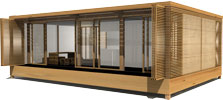

The design for the team's house design appears simple, with an exterior of oak and glass, but the low-tech appearance hides many high-tech devices. The translucent side walls shown in this image were later replaced with solid walls.
Download Construction Drawings
(Zip 44 MB)
Neither the United States, nor the Department of Energy, nor the Alliance for Sustainable Energy LLC, nor any of their contractors, subcontractors, or their employees make any warranty, express or implied, or assume any legal liability or responsibility for the accuracy, completeness, or usefulness for any purpose of any technical resources or data attached or otherwise presented here as reference material.
Solar Decathlon 2007
Technische Universität Darmstadt
Team Web site: www.solardecathlon.de
Germany's Newest Export Product
"Made in Germany" is a phrase that applies well to the Solar Decathlon entry from the Technische Universitat Darmstadt, because the team wants to present the German way of building, showcasing German technologies and materials in their solar house, including German oak.
The emphasis on "Made in Germany" products and technologies is apparent in the team's collaboration with German companies and manufacturers, such as Bosch, which provided three-month internships for two Darmstadt students. That arrangement provided a test bed for the students to study the performance of the systems that will provide hot water and climate control for the house.
"It was very interesting because we had all those experts right next to us, and when we had specific questions, we always got very good answers very quickly," says Toby Kern, an architecture student who was one of the interns.
After the Solar Decathlon, the house will return to Germany to be used as a solar power plant, as part of the university's project of a Solar Campus ("Solare Lichtwiese"), through which all buildings on campus will be equipped with building-integrated photovoltaics, feeding electricity into the German power grid.
Germany has a "solar feed-in tariff" that provides a guaranteed price for any solar power that is fed into the German power grid. Because the feed-in tariff is high enough to more than cover the cost of the installation over the long term, the university is selling shares to the public to finance these photovoltaic systems. This yields a return for the investors as the revenue from selling the power is split among them. The Solar Decathlon house will be the first piece in this ambitious project—continuing to showcase the potential of building-integrated solar power generation.
Team Contact
Manfred Hegger
fg@ee.tu-darmstadt.de
